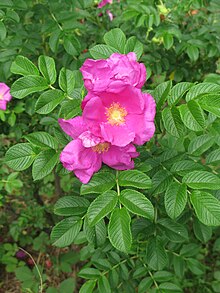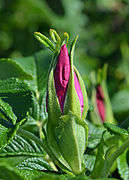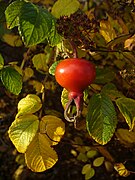Rosa rugosa
| Rosa rugosa | |
|---|---|
 | |
| Rosa rugosa flower | |
| Scientific classification | |
| Kingdom: | Plantae |
| (unranked): | Angiosperms |
| (unranked): | Eudicots |
| (unranked): | Rosids |
| Order: | Rosales |
| Family: | Rosaceae |
| Genus: | Rosa |
| Species: | R. rugosa |
| Binomial name | |
| Rosa rugosa Thunb. | |
Rosa rugosa (rugosa rose, beach rose, Japanese rose, or Ramanas rose) is a species of rose native to eastern Asia, in northeastern China, Japan, Korea and southeastern Siberia, where it grows on the coast, often on sand dunes.[1] It should not be confused with Rosa multiflora, which is also known as "Japanese rose". The Latin word "rugosa" means "wrinkled."
Contents
[hide]Description[edit]
Rosa rugosa is a suckering shrub which develops new plants from the roots and forms dense thickets 1–1.50 m tall with stems densely covered in numerous short, straight prickles 3–10 mm long. The leaves are 8–15 cm long, pinnate with 5–9 leaflets, most often 7, each leaflet 3–4 cm long, with a distinctly corrugated (rugose, hence the species' name) surface. The flowers are pleasantly scented, dark pink to white (on R. rugosa f. alba (Ware) Rehder), 6–9 cm across, with somewhat wrinkled petals; flowering occurs in spring.[1]
The hips are large, 2–3 cm diameter, and often shorter than their diameter, not elongated; in late summer and early autumn the plants often bear fruit and flowers at the same time. The leaves typically turn bright yellow before falling in autumn.[citation needed]
|
Cultivation and uses[edit]
Rosa rugosa is widely used as an ornamental plant. It has been introduced to numerous areas of Europe and North America. It has many common names, several of which refer to the fruit's resemblance to a tomato, including beach tomato or sea tomato; others include saltspray rose, beach rose, potato rose and Turkestan rose.[2] In parts of the US the fruits are also occasionally called beach plums, causing confusion with the plant properly bearing that name, Prunus maritima.[3]
The sweetly scented flowers are used to make pot-pourri in Japan and China, where it has been cultivated for about a thousand years.[citation needed] It is used in traditional Chinese medicine to treat irregular menstruation and gastritis.[4]
This species hybridises readily with many other roses,[2] and is valued by rose breeders for its considerable resistance to the diseases rose rust and rose black spot. It is also extremely tolerant of seaside salt spray and storms, commonly being the first shrub in from the coast. It is widely used in landscaping, being relatively tough and trouble-free. Needing little maintenance, it is suitable for planting in large numbers; its salt-tolerance makes it useful for planting beside roads which need deicing with salt regularly.[citation needed]
Numerous cultivars have been selected for garden use, with flower colour varying from white to dark red-purple, and with semi-double to double flowers where some or all of the stamens are replaced by extra petals. Popular examples include 'Fru Dagmar Hastrup' (pink, single), 'Pink Grootendorst' (pink, semi-double), 'Blanc Double de Coubert' (white, double) and the more common 'Roseraie de L'Haÿ' (pink, double), which is often used for its very successful rootstock and its ornamental rose hips.[citation needed]
Invasive species[edit]
Rosa rugosa is naturalized in many parts of Europe, and it is considered an invasive species in some habitats, particularly in seashores of Northern Europe. It can outcompete native flora, thereby threatening biological diversity.[5] on Sylt, an island in the north of Germany, it is sufficiently abundant to have become known as the "Sylt rose".[2] It is also considered a noxious weed in the USA.[6]
R. rugosa was first introduced into North America in 1845. The first report of it being naturalized far from the location in which it was planted occurred on Nantucket in 1899. Ten years later it was said to be "straying rapidly" and today it is naturalized on the entire coast of New England.
Vernacular names[edit]
In Japanese, it is called hamanasu (浜茄子) "beach aubergine", hamanashi (浜梨) "beach pear" or simply 玫瑰 "rose". The Chinese call it méiguī huā 玫瑰花. In Korean, the species is called haedanghwa (Hangul: 해당화, 海棠花), literally "flowers near the seashore".[7][citation needed]
'뉴욕 市' 카테고리의 다른 글
| Rosa multiflora (0) | 2018.03.03 |
|---|---|
| 찔레꽃 (0) | 2018.03.03 |
| 해당화 (0) | 2018.03.03 |
| 동백나무 (0) | 2018.03.03 |
| Jackson Heights, Queens (0) | 2018.02.19 |



